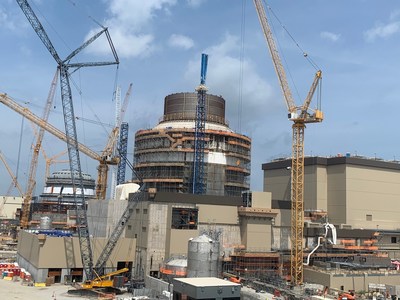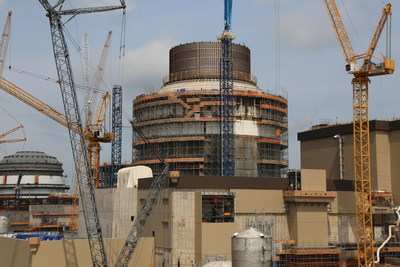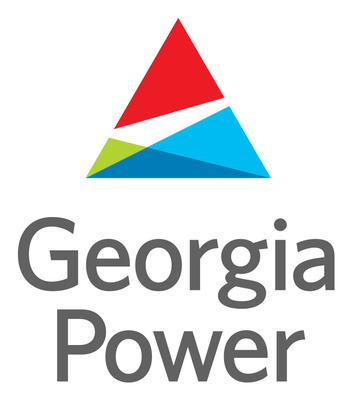ATLANTA, May 22, 2020 /PRNewswire/ -- The final module for Georgia Power's Vogtle Unit 3, a massive water tank, has been placed atop the containment vessel and shield building roof at the company's Vogtle 3 & 4 nuclear expansion project near Waynesboro, Georgia. The installation represents the final module placement for Unit 3, marking another significant milestone for the project.
The large module, known as CB-20, is a major part of the AP1000 reactor's advanced passive safety system. Standing 35 feet tall and weighing more than 720,000 pounds, the large component will hold approximately 750,000 gallons of water ready to flow down in the unlikely event of an emergency to help cool the reactor. The water can also be directed into the used fuel pool, while the tank itself can be refilled from water stored elsewhere on site.
The AP1000 plant's passive safety systems require no operator actions to mitigate potential emergency situations. These systems use only natural forces such as gravity, natural circulation and compressed gas to achieve their safety function. No pumps, fans, diesels, chillers or other active machinery are used, except for a few simple valves that automatically align and actuate the passive safety systems.
The modules used for Vogtle units 3 & 4 help streamline the construction process, since they were made in advance of arriving to the project site and ready to be assembled into larger components that make up the nuclear units. Since 2011, major modules have been delivered to the site by rail and truck, and included a range of plant components such as floor and wall sections and supporting structures that surround the containment buildings and reactor vessels. The final major module arrived at the construction site in late 2019, meaning all 1,485 major modules required to complete construction had been manufactured and safely delivered.
Key Milestones
The placement of the CB-20 module follows the placement of the Unit 3 integrated head package (IHP) atop the reactor vessel. Standing 48 feet tall, weighing 475,000 pounds and containing more than three miles of electrical cables, the IHP is an integral component that will eventually be used by highly-trained nuclear operators to monitor and control the nuclear reaction that will occur inside the Unit 3 reactor vessel.
Additional milestones achieved over the last few months include:
- Completion of Open Vessel Testing for Unit 3 - This successfully demonstrated how water flows from the key safety systems into the reactor vessel ensuring the paths are not blocked or constricted, and confirmed the pumps, motors, valves, pipes and other components of the systems function as designed.
- Placement of the polar crane and containment vessel top for Unit 4 – This signifies that all major lifts inside the containment vessels for both units are now complete.
- Operation of the Unit 3 main control room - Operators begin monitoring and controlling the technology and equipment essential for testing the unit's systems and safely starting the plant.
- Placement of the Unit 3 shield building roof - The two-million-pound roof covers the top of the shield building, which provides an additional layer of safety around the containment vessel and nuclear reactor to protect the structure from any potential impacts.
- Final concrete placement inside the Unit 3 containment vessel - Completing this milestone is an important step that allows for the installation of machinery that will be used to load fuel into the unit.
Historic milestones accomplished over the past year include:
- Ordering the first nuclear fuel loads for both units 3 & 4. Consisting of 157 fuel assemblies with each measuring 14 feet tall, the fuel will eventually be loaded into the reactor vessels to support startup once the reactors begin operating.
- Placing the containment vessel top heads for both units, marking that the project's final major lifts inside the containment vessels are complete. The containment vessel is a high-integrity steel structure that houses critical plant components.
- Completing the first emergency preparedness drill for the new units, which includes a comprehensive review of the site's plans to ensure the protection of the public. The emergency preparedness plan specifies the response actions if the site were ever to experience an incident.
- Finalizing Department of Energy (DOE) loan guarantees for the Vogtle 3 & 4 project. Through the company's $5.13 billion loan guarantee capacity with the DOE, Georgia Power customers are expected to save approximately $550 million in financing costs overall.
- Completing the multi-year training necessary for the nuclear operators required for the new units, which culminated with the Nuclear Regulatory Commission (NRC) license exam. From the main control room, operators will monitor and control the technology and equipment essential for testing the unit's systems and safely starting the plant.
With more than 7,000 workers on site, and more than 800 permanent jobs available once the units begin operating, Vogtle 3 & 4 is currently the largest jobs-producing construction project in the state of Georgia.
Follow the progress being made at the site with the Plant Vogtle 3 & 4 Online Photo Gallery and Georgia Power YouTube channel.
Benefits to Customers
The new Vogtle units, with regulatory-approved in-service dates of November 2021 for Unit 3 and November 2022 for Unit 4, are an essential part of Georgia Power's commitment to deliver safe, clean, reliable and affordable energy for customers. Once operating, the two new units at Plant Vogtle will be able to power more than 500,000 homes and businesses and provide customers with a new carbon-free energy source that is expected to put downward pressure on rates for 60 to 80 years. A diverse fuel mix, including nuclear, is also essential to maintaining a reliable and affordable energy infrastructure that attracts new investment, supports economic growth and creates jobs.
About Georgia Power
Georgia Power is the largest electric subsidiary of Southern Company (NYSE: SO), America's premier energy company. Value, Reliability, Customer Service and Stewardship are the cornerstones of the company's promise to 2.6 million customers in all but four of Georgia's 159 counties. Committed to delivering clean, safe, reliable and affordable energy at rates below the national average, Georgia Power maintains a diverse, innovative generation mix that includes nuclear, coal and natural gas, as well as renewables such as solar, hydroelectric and wind. Georgia Power focuses on delivering world-class service to its customers every day and the company is consistently recognized by J.D. Power and Associates as an industry leader in customer satisfaction. For more information, visit www.GeorgiaPower.com and connect with the company on Facebook (Facebook.com/GeorgiaPower), Twitter (Twitter.com/GeorgiaPower) and Instagram (Instagram.com/ga_power).
Cautionary Note Regarding Forward-Looking Statements
Certain information contained in this release is forward-looking information based on current expectations and plans that involve risks and uncertainties. Forward-looking information includes, among other things, statements concerning the completion of construction and future operation of Plant Vogtle units 3 and 4, the expected benefits of the DOE loan guarantees, and expected job creation. Georgia Power cautions that there are certain factors that can cause actual results to differ materially from the forward-looking information that has been provided. The reader is cautioned not to put undue reliance on this forward-looking information, which is not a guarantee of future performance and is subject to a number of uncertainties and other factors, many of which are outside the control of Georgia Power; accordingly, there can be no assurance that such suggested results will be realized. The following factors, in addition to those discussed in Georgia Power's Annual Report on Form 10-K for the year ended December 31, 2019 and subsequent securities filings, could cause actual results to differ materially from management expectations as suggested by such forward-looking information: the potential effects of the COVID-19 pandemic, including extended disruptions to supply chains and further reduced labor availability and productivity, which could have a variety of adverse impacts, including a negative impact on the ability to develop, construct, and operate facilities, including, but not limited to, Plant Vogtle Units 3 and 4; the ability to control costs and avoid cost and schedule overruns during the development, construction, and operation of facilities or other projects, including Plant Vogtle Units 3 and 4, which includes components based on new technology that only within the last few years began initial operation in the global nuclear industry at this scale, and including changes in labor costs, availability and productivity, challenges with management of contractors or vendors, subcontractor performance, adverse weather conditions, shortages, delays, increased costs, or inconsistent quality of equipment, materials, and labor, contractor or supplier delay, delays due to judicial or regulatory action, nonperformance under construction, operating, or other agreements, operational readiness, including specialized operator training and required site safety programs, engineering or design problems, design and other licensing-based compliance matters, including, for nuclear units, the timely submittal by Southern Nuclear of the Inspections, Tests, Analyses, and Acceptance Criteria documentation for each unit and the related reviews and approvals by the U.S. Nuclear Regulatory Commission ("NRC") necessary to support NRC authorization to load fuel, challenges with start-up activities, including major equipment failure, system integration or regional transmission upgrades, and/or operational performance; the ability to overcome or mitigate the current challenges at Plant Vogtle Units 3 and 4, including, but not limited to, those related to COVID-19, that could impact the cost and schedule for the project; legal proceedings and regulatory approvals and actions related to construction projects, such as Plant Vogtle Units 3 and 4 and pipeline projects, including Public Service Commission approvals and Federal Energy Regulatory Commission and NRC actions; under certain specified circumstances, a decision by holders of more than 10% of the ownership interests of Plant Vogtle Units 3 and 4 not to proceed with construction and the ability of other Vogtle owners to tender a portion of their ownership interests to Georgia Power following certain construction cost increases; the ability to construct facilities in accordance with the requirements of permits and licenses (including satisfaction of NRC requirements), to satisfy any environmental performance standards and the requirements of tax credits and other incentives, and to integrate facilities into the Southern Company system upon completion of construction; the inherent risks involved in operating and constructing nuclear generating facilities; the ability of counterparties of Georgia Power to make payments as and when due and to perform as required; the direct or indirect effect on Georgia Power's business resulting from cyber intrusion or physical attack and the threat of physical attacks; catastrophic events such as fires, earthquakes, explosions, floods, tornadoes, hurricanes and other storms, droughts, pandemic health events or other similar occurrences; and the direct or indirect effects on Georgia Power's business resulting from incidents affecting the U.S. electric grid, natural gas pipeline infrastructure, or operation of generating or storage resources. Georgia Power expressly disclaims any obligation to update any forward‐looking information.
SOURCE Georgia Power




